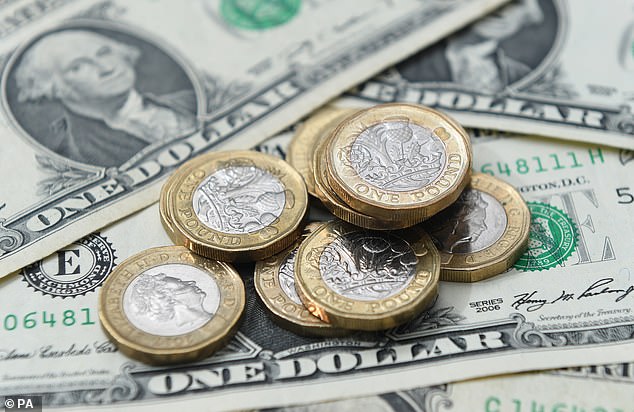Table of Contents
The pound rose to its highest level in a year after strong economic growth raised fresh doubts about when interest rates will finally be cut.
As the Office for National Statistics (ONS) revealed that output is rising at the fastest pace in two years, sterling rose a penny to a high of $1.2947.
The UK currency was also boosted by data showing US inflation fell more sharply than expected to 3 percent last month, weakening the dollar.
The UK figures dented hopes that the Bank of England would cut interest rates next month, which remain at 5.25 percent, the highest level in 16 years.
Sterling rises: The Office for National Statistics revealed that output is rising at the fastest pace in two years, with sterling up a penny to $1.2947
At the same time, falling inflation in the United States suggests that the US central bank, the Federal Reserve, could cut rates sooner than previously thought.
The result in currency markets, where higher interest rates strengthen a currency while lower borrowing costs do the opposite, was a stronger pound and a weaker dollar.
“The pound has been supported by further evidence that the UK economy is recovering more strongly than expected,” said Lee Hardman, currency analyst at MUFG.
ONS figures showed the economy grew by 0.4 per cent in May, twice as fast as expected.
And in the three months through May, output was 0.9 percent higher than in the previous three months, the strongest pace of growth since January 2022.
That could persuade the Bank of England’s wavering interest rate setters to postpone cuts when they meet on August 1.
This is the latest brake on market expectations of a rate cut.
Hopes had been fuelled by a fall in inflation to the Bank of England’s 2 per cent target.
Earlier this week, market prices were indicating a 60/40 chance of a cut in August, but now that probability is closer to 50/50.
And Chancellor Rachel Reeves said yesterday that while the bank was “rightly independent”, the public “would welcome some relief in the form of lower mortgage costs”.
However, hopes for a cut have been dashed, first by cautious speeches from the Bank of England’s chief economist Huw Pill and his fellow rate-setter Catherine Mann, who indicated they were still concerned about underlying inflationary pressures.
And they suffered another hit to GDP figures, adding to evidence that the economy is recovering after a recession late last year.
The UK enjoyed 0.7 per cent growth in the first quarter, rated as “excellent” by the ONS.
Investment bank Goldman Sachs yesterday raised its forecast for UK GDP in 2024 from 1.1 percent to 1.2 percent.
Suren Thiru, economics director at the Institute of Chartered Accountants in England and Wales, said: “These GDP figures may make an August rate cut less likely by giving rate-setters, concerned about underlying price pressures, enough confidence about the UK’s economic recovery to continue postponing policy easing.”
Sterling has also been encouraged by the prospects of the new Labour government.
Shahab Jalinoos, global head of currency research at UBS Investment Bank in New York, said: “The UK now arguably has the most stable government in the G7 over the next five years, because of the size of the majority.”
DIY INVESTMENT PLATFORMS

AJ Bell

AJ Bell
Easy investment and ready-to-use portfolios

Hargreaves Lansdown

Hargreaves Lansdown
Free investment ideas and fund trading

interactive investor

interactive investor
Flat rate investing from £4.99 per month

eToro

eToro
Stock Investing: Community of Over 30 Million

Trade 212

Trade 212
Free and commission-free stock trading per account
Affiliate links: If you purchase a product This is Money may earn a commission. These offers are chosen by our editorial team as we believe they are worth highlighting. This does not affect our editorial independence.


